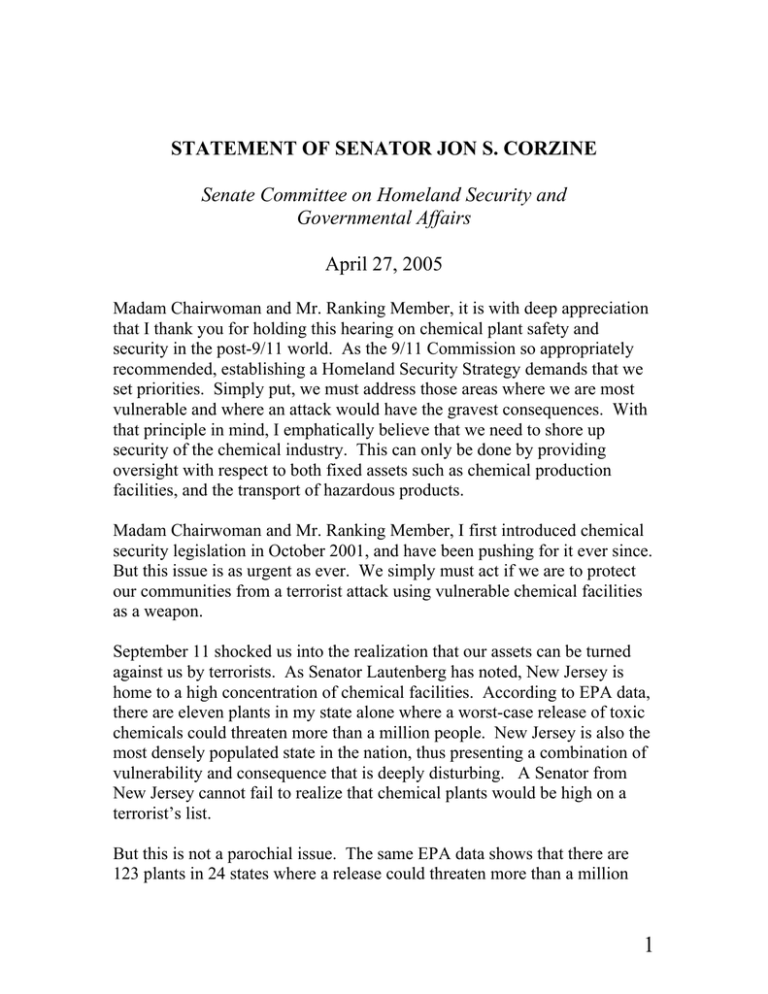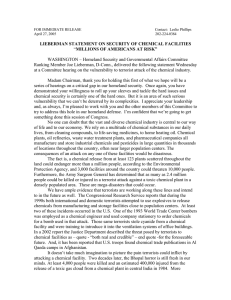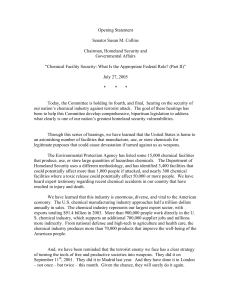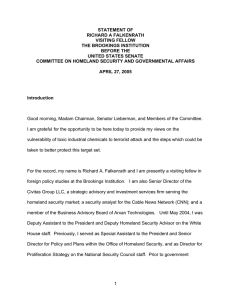April 27, 2005 STATEMENT OF SENATOR JON S. CORZINE
advertisement

STATEMENT OF SENATOR JON S. CORZINE Senate Committee on Homeland Security and Governmental Affairs April 27, 2005 Madam Chairwoman and Mr. Ranking Member, it is with deep appreciation that I thank you for holding this hearing on chemical plant safety and security in the post-9/11 world. As the 9/11 Commission so appropriately recommended, establishing a Homeland Security Strategy demands that we set priorities. Simply put, we must address those areas where we are most vulnerable and where an attack would have the gravest consequences. With that principle in mind, I emphatically believe that we need to shore up security of the chemical industry. This can only be done by providing oversight with respect to both fixed assets such as chemical production facilities, and the transport of hazardous products. Madam Chairwoman and Mr. Ranking Member, I first introduced chemical security legislation in October 2001, and have been pushing for it ever since. But this issue is as urgent as ever. We simply must act if we are to protect our communities from a terrorist attack using vulnerable chemical facilities as a weapon. September 11 shocked us into the realization that our assets can be turned against us by terrorists. As Senator Lautenberg has noted, New Jersey is home to a high concentration of chemical facilities. According to EPA data, there are eleven plants in my state alone where a worst-case release of toxic chemicals could threaten more than a million people. New Jersey is also the most densely populated state in the nation, thus presenting a combination of vulnerability and consequence that is deeply disturbing. A Senator from New Jersey cannot fail to realize that chemical plants would be high on a terrorist’s list. But this is not a parochial issue. The same EPA data shows that there are 123 plants in 24 states where a release could threaten more than a million 1 people. And there are 39 states that have at least one facility where such a release could threaten more than 100,000 people. I know from personal experience the vulnerabilities of many of these facilities. In June of last year, I joined a crew from 60 Minutes at a chemical plant outside Pittsburgh. There was an open gate in front of the most dangerous chemicals at the plant. We walked in, gaining access to incredibly toxic chemicals. We saw anhydrous ammonia that searches out wet parts of the body, goes down the throat, rips out the lungs and blinds the victim. We also saw boron triflouride, a deadly colorless gas with a suffocating odor that attacks mucous membranes. It can kill at concentrations as low as 50 PPM. The consequences of an attack on a these and other chemical facilities and their continued vulnerability have prompted alarming – but entirely accurate – testimony. In January, former Deputy Homeland Security Advisor to the President, Richard Falkenrath, who you will hear from again later today, testified to this Committee that the threat of industrial chemicals is “acutely vulnerable and almost uniquely dangerous” and that “toxic-by-inhalation industrial chemicals present a mass-casualty terrorist potential rivaled only by improvised nuclear devices, certain acts of bioterrorism, and the collapse of large, occupied buildings.” Madam Chairwoman and Mr. Ranking Member, despite these and many other warnings by public officials and anti-terrorism experts, there is still no federal law requiring chemical facilities to assess vulnerabilities or to safeguard against a terrorist attack. The federal government has made no serious efforts to reduce the vulnerability of chemical facilities, nor does it have the authority to do so. I believe, however, that there is, in fact, real support for new legislation. The chemical security bill that I introduced in the 107th Congress passed the Environmental and Public Works Committee by a vote of 19-0. This consensus surrounding this issue is indeed broad —the EPA, the Justice Department, the Nuclear Regulatory Commission, GAO, industry groups, and public safety groups all agree that government must act. The White House Strategy for Homeland Security recognizes the chemical and hazardous materials sector as an infrastructure protection priority. As Secretary of Homeland Security Ridge forcefully testified on July 10, 2002: 2 “The fact is, we have a very diversified economy and our enemies look at some of our economic assets as targets. And clearly, the chemical facilities are one of them. We know that there have been reports validated about security deficiencies at dozens and dozens of those.” Madam Chairwoman and Mr. Ranking Member, chemical security legislation is necessary to protect our communities. Let me be clear: it is not an attempt to vilify our nations’ chemical companies. Indeed, these companies are a key part of our industrial fabric, providing jobs and producing products essential to our lives. This is certainly true of my home state of New Jersey, as I have already indicated. Some companies have taken actions and are continuing to work to implement security measures. Others, however, are not. That’s one crucial reason why federal regulation is needed. We must be able to assure our constituents that this major vulnerability is being addressed in a comprehensive manner and that certain minimum standards are being met throughout the country. We have already addressed other infrastructure vulnerabilities. Most notably, we require nuclear power plants to meet extensive security standards as a condition of their operating licenses. I think we ought to tighten those standards, but the fact is that we have no standards at all for our chemical facilities. Addressing the risk to communities from a terrorist-caused release of hazardous chemicals requires two fundamental components. The first is improving plant perimeter security, so that the likelihood of a successful terrorist attack is lowered. The second is reducing hazards, in the production process, so that the impact of a successful attack is minimized. Under the legislation I have proposed, the federal government would identify high priority chemical facilities and then require those facilities to assess vulnerabilities and hazards and develop and implement a plan to improve security and use safer technologies. Among the factors used to identify these facilities are the severity of harm that could be caused by a chemical release, proximity to population centers, threats to national security or critical infrastructure, threshold quantities of substances of concern that pose a serious threat, and such other relevant safety or security factors. 3 Next, I believe that chemical security legislation should require chemical facilities to work with local law enforcement and first responders, in developing the assessments and plans. September 11 showed us how brave and important our first responders are. Every day, they stand ready to risk their lives to respond to terrorist attacks. They ought to be a part of the process for developing vulnerability assessments and response plans. Chemical facility employees should also be consulted. They are most at risk in case of a terrorist attack on their plants. They also work in the plants every day and have ideas about how to secure the facilities and reduce hazards. As to the assessments and plans themselves, requirements in any legislation would be fairly general. I’m not advocating a one-size-fits-all approach. Each facility would be required to prepare prevention, preparedness and response plan that incorporates the results of the assessments. The plan must include actions and procedures, including safer design and maintenance, to eliminate or significantly lessen the potential consequences of a release. What this means in simple terms, is that each facility has to develop a plan and take steps to reduce both the likelihood of a successful attack and the harm that would occur if an attack were successful. In other words, they have to look at traditional security measures, such as fences, alarms, and guards. But they also have to look at whether they can make the plant safer. In other words, can less hazardous chemicals be used? Can containment technology such as fans or scrubbers be improved or employed to contain chemicals that may be released? Chemical facilities ought to evaluate the full range of options, look at the tradeoffs among them, and go forward with the best mix of security and technology options. Facilities would then be required to send their assessments and plans to the Department of Homeland Security which must review those assessments and plans, and certify compliance with the regulations. The certification process would be there to assure the public that facilities are complying with the law. Those certifications would be the only information from the assessments and plans that is publicly available. All other information produced under the bill—most importantly, the assessments and plans themselves—would be exempt from disclosure under the Freedom of Information Act. I don’t take FOIA exemptions lightly. I believe strongly that, in general, the public has a right to information collected by the government. But I think it’s pretty 4 obvious that in the case of the information that would be submitted to the government under this bill—the vulnerability assessments and response plans—we simply cannot allow the security details in these plans to be publicly available. But I think it does make sense that people who live near a chemical plant be able to find out whether or not that plant has complied with the law. Legislation should require the Department of Homeland Security to develop protocols to prevent unauthorized disclosure of those documents. It would attach penalties to unauthorized disclosure. Madam Chairwoman, Mr. Ranking Member, in recent years, two contentious issues have arisen that I would like to address. The first is the question of private action and industry standards. Let me be repeat: there has been important work done both by individual owners and operators and by industry as a whole. This work should be recognized, applauded and encouraged. We must build on what has already been done. But what chemical security legislation should not do is provide a blanket substitution of industry guidelines in the place of federal standards. The Department of Homeland Security has the expertise and the intelligence necessary to defend us from terrorism. We must allow the Department to do its job. With millions of lives at risk, we simply cannot outsource our security. The second question involves the “alternative approaches” – ways in which we can mitigate the consequences of an attack by changing the chemicals or the manufacturing process. Madam Chairwoman, Mr. Ranking Member, chemical facilities can improve security by reinforcing storage tanks. They can hire more security officers and train them better. They can build higher walls and fences, and improve detection devices. But no security regime will ever be impenetrable. We saw on September 11 what terrorists can do merely by taking over a few airplanes. We cannot assume that “guns, gates and guards” will always provide airtight security. We simply have to prepare for the possibility that a committed terrorist will find a way to release toxic chemicals. To truly protect the public, therefore, we need to make chemical plants less attractive targets in the first place. We can do that by ensuring that, if a facility is attacked, the threat to human life is minimized. We have seen a great example of how that can work right here in Washington DC, at the 5 Blue Plains Sewage Treatment Plant. Prior to September 11, the plant stored seven tank cars, consisting of about 550 tons of chlorine and sulfur dioxide. Both are very volatile, dangerous chemicals. If these tanks were attacked, a poisonous cloud could have blanketed Washington DC—including the Capitol and the White House. Though the threat had been there for years, September 11 changed the way that plant managers thought about everything. I’d like to quote Mike Marcotte, the plant’s manager, who said: “After a sleepless night on the 11th I came in on the 12th and convened a number of my engineers and said, ‘I think we need to come up with a plan to get the chlorine out of here as quickly as possible.’” And that’s what they did. They replaced the chlorine with sodium hypochlorite—a strong version of the bleach that we all use at home. It is a bit more expensive to use. Blue Plains officials have estimated that it will cost each household 25-50 cents more per year because of the switch. But that’s a small price to pay to eliminate the possibility of a chlorine release across Washington DC. If the plant manager at Blue Plains can put our nation’s security first, so too can Congress. We can ensure that our government has the authority to secure the thousands of still vulnerable chemical facilities around the country. We can and must act. New instances of accidents, including the explosion in Texas City on March 23 that killed 15 workers and injured 100, or the explosion on January 25, in Perth Amboy, NJ that killed three, offer a hint of what would happen if terrorists deliberately attacked a chemical facility. Madam Chairman, Mr. Ranking Member, if we knew ahead of time of a looming threat to our children, wouldn’t we do everything we could to stop it? And, in the end, shouldn’t we be asking ourselves this horrible question: “What if this nightmare had already happened? Then how would we respond?” Thank you, Madam Chairman, Mr. Ranking Member. I deeply appreciate the opportunity to testify before you today and look forward to working with you on this critically important issue. 6






